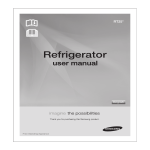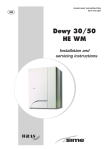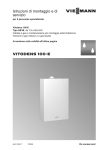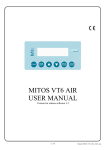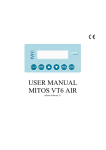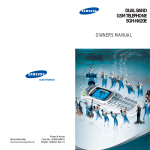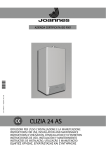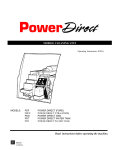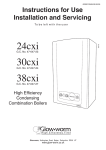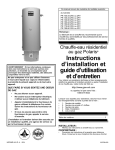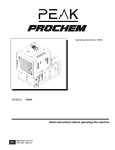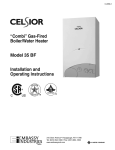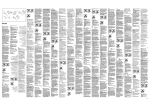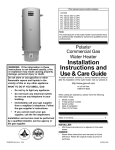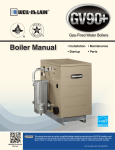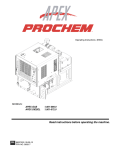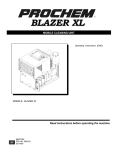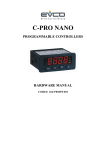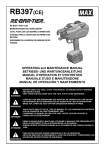Download Dewy 30/130 HE FS - Heating and Hotwater Industry Council
Transcript
UK PLEASE LEAVE THIS INSTRUCTION WITH THE USER Dewy 30/130 HE FS Installation and servicing instructions SAFE HANDLING This boiler may require 2 or more operatives to move it into its installation site, remove it from its packaging and during movement into its installation location. Manoeuvring the boiler may include the use of a sack truck and involve lifting pushing and pulling. Caution should be exercised during these operations. Operatives should be knowledgeable in handling techniques when performing these tasks and the following precautions should be considered: – Grip the boiler at the base – Be physically capable – Use personal protective equipment as appropriate e.g. gloves, safety footwear. During all manoeuvres and handling actions, every attempt should be made to ensure the following unless unavoidable and/or the weight is light. – Keep back straight – Avoid twisting at the waist – Always grip with the palm of the hand – Keep load as close to the body as possible – Always use assistance WARNING Caution should be exercised when performing any work on this appliance. Protective gloves and safety glasses are recommended. – Avoid direct contact with sharp edges. – Avoid contact with any hot surfaces. NOTICE Please be aware that due to the wet testing of the appliance, there may some residual water in the hydraulic circuit. – Protect any surfaces, carpets or floorings. – Use a suitable container to catch any water that escape when removing the protective caps from the connections. All descriptions and illustrations provided in this manual have been carefully prepared but we reserve the right to make changes and improvements in our products that may affect the accuracy of the information contained in this manual. The Benchmark Scheme Sime Ltd is a licensed member of the Benchmark Scheme which aims to improve the standards of installation and commissioning of domestic heating and hot water systems in the UK and to encourage regular servicing to optimise safety, efficiency and performance. Benchmark is managed and promoted by the Heating and Hotwater Industry Council. For more information visit www.centralheating.co.uk IPX4D Dewy 30/130 HE FS: Gas Council number 47-283-05 These appliances comply with the S.E.D.B.U.K. scheme, band “A” CONTENTS 1 DESCRIPTION OF THE BOILER . . . . . . . . . . . . . . . . . . . . . . . . . . . . . . . . . . . . . . . . . . . . . . . . . . . . . . . . . . . . . . . . pag. 6 2 INSTALLATION . . . . . . . . . . . . . . . . . . . . . . . . . . . . . . . . . . . . . . . . . . . . . . . . . . . . . . . . . . . . . . . . . . . . . . . . . . . . . . pag. 10 3 4 CHARACTERISTICS . . . . . . . . . . . . . . . . . . . . . . . . . . . . . . . . . . . . . . . . . . . . . . . . . . . . . . . . . . . . . . . . . . . . . . . . . . pag. USE COMMISSIONING, AND MAINTENANCE (including BENCHMARK/Mains Pressure Hot Water Storage Checklist & Service Record) . . . . . . pag. 19 23 5 EXPLODED VIEWS . . . . . . . . . . . . . . . . . . . . . . . . . . . . . . . . . . . . . . . . . . . . . . . . . . . . . . . . . . . . . . . . . . . . . . . . . . . pag. 32 Important Information IT IS A STATUTORY REQUIREMENT THAT ALL GAS APPLIANCES ARE INSTALLED BY COMPETENT PERSONS, IN ACCORDANCE WITH THE GAS SAFETY (INSTALLATION AND USE) REGULATIONS (CURRENT EDITION). The manufacturer’s instructions must not be taken as overriding any statutory requirements, and failure to comply with these regulations may lead to prosecution. No modifications to the appliance should be made unless they are fully approved by the manufacturer. GAS LEAKS: DO NOT OPERATE ANY ELECTRICAL SWITCH, OR USE A NAKED FLAME. TURN OFF THE GAS SUPPLY AND VENTILATE THE AREA BY OPENING DOORS AND WINDOWS CONTACT THE GAS EMERGENCY SERVICE ON 0800111999. Please refer to commissioning instructions for filling in the checklist of this installation guide. Note: All Gas Safe registered installers carry a ID Card. You can check your installer is Gas Safe Registered by calling 0800 408 5577 IMPORTANT When carrying out commissioning of the boiler, you are highly recommended to perform the following checks: – Make sure that there are no liquids or inflammable materials in the immediate vicinity of the boiler. – Make sure that the electrical connections have been made correctly and that the earth wire is connected to a good earthing system. – Open the gas tap and check the soundness of the connections, including that of the burner. – Make sure that the boiler is set for operation for the type of gas supplied. – Check that the flue pipe for the outlet of the products of the combustion is unobstructed and has been properly installed. – Make sure that any shutoff valves are open. – Make sure that the system is charged with water and is thoroughly vented. – Check that the circulating pump is not locked (CAUTION: Remember to release the pump coupled with the control panel, if necessary, to protect the electronic control card). – Purge the system, bleeding off the air present in the gas pipe by operating the pressure relief valve on the gas valve inlet. – Check that the syphened drip is fully filled with water. If necessary, fill it via the special opening. – Ensure that the Benchmark checklist in the use and maintenance section of this manual is completed. 1 DESCRIPTION OF THE BOILER 1.1 INTRODUCTION “DEWY 30/130 HE FS” boilers are premix condensation thermal appliances which use microprocessor technology for function These appliances can be fired by natural gas (methane) and propane gas (G31). The instructions given in this manual are provided to ensure proper installation and perfect operation of the appliance. DIMENSIONS 610 600 65 1.2 control and management. They comply with the european directives 90/396/CEE, 2004/108/CE, 2006/95/CE, 92/42/CEE and with the european specifications EN 483 - EN 625. 252 76 140 M2 R2 M1 R1 M R 70 70 315 S1 117 1620 C1 62 U S3 828 846 712 946 1349 1229 1109 G 349 C 109 E S2 300 300 E SUPPLIED WITH THE BOILER: - Pressure reducing valve - Single check valve - Expansion relief valve and associated tundish Fig. 1 SERVICE CLEARANCES CONNECTIONS R R1 R2 M2 M1 M G E U S1/S2 S3 6 Zone 1 system return Zone 2 system return (optional) Zone 3 system return (optional) Zone 3 system delivery (optional) Zone 2 system delivery (optional) Zone 1 system delivery Gas connection D.H.W. inlet D.H.W. outlet C.H. safety relief valve/tank Condensation outlet ø 25 3/4” (UNI-ISO 228/1) 3/4” (UNI-ISO 228/1) 3/4” (UNI-ISO 228/1) 3/4” (UNI-ISO 228/1) 3/4” (UNI-ISO 228/1) 3/4” (UNI-ISO 228/1) 3/4” (UNI-ISO 228/1) 3/4” (UNI-ISO 228/1) 3/4” (UNI-ISO 228/1) ABOVE THE APPLIANCE CASING AT THE R.H.S. AT THE L.H.S. IN FRONT OF THE APPLIANCE 300 mm 300 mm 300 mm 700 mm ACCESS TO THE CONNECTIONS AT THE REAR OF THE BOILER MUST BE PROVIDED. 1.3 TECHNICAL FEATURES DEWY 30/130 HE FS Heat output Nominal (80-60°C) Minimum (80-60°C) Nominal (50-30°C) Minimum (50-30°C) Nominal D.H.W. heat output Heat input Nominal/Minimum Efficiency (80-60°C) Nominal/Minimum output Efficiency (50-30°C) Nominal/Minimum output Water content Electrical supply Adsorbed power consumption Electrical protection grade C.H. pressure relief valve setting Maximum C.H. working pressure Maximum temperature Expansion vessel Capacity Preloading pressure C.H. setting range D.H.W. setting range D.H.W. production Maximum D.H.W. supply pressure D.H.W. flow rate (EN 625) Continuous D.H.W. flow rate ∆t 30°C D.H.W. operating pressure Maximum D.H.W. pressure D.H.W. tank capacity D.H.W. expansion vessel D.H.W. expansion vessel charge pressure D.H.W. tank heating time between 15 and 60°C Recuperation time between 25 and 55°C Recuperation time to raise 70% of volume to 60°C D.H.W. expansion relief valve setting Combined temperature & pressure relief valve setting Combined temperature & pressure relief valve setting Smokes temperature Maximum/ Minimum (80-60°C) Maximum/ Minimum (50-30°C) Smokes flow Category Type Weight Weight (full) Main burner nozzles Quantity G20 G25 G31 Gas consumption Nominal / Minimum (G20) Nominal / Minimum (G25) Nominal / Minimum (G31) Gas supply pressure G20 G25 G31 (Propan) CO2 % methane (G20) CO2 % methane (G25) CO2 % propan (G31) CO emission NOx emission (Class 5) (1) Flow kW (kcal/h) kW (kcal/h) kW (kcal/h) kW (kcal/h) kW 29,3 (25.200) 10,4 (9.000) 32,0 (27.600) 11,4 (9.800) 29,3 kW 30,0 / 10,8 % 97,7 / 96,7 % l bar bar °C 106,8 / 105,8 10,9 230V 50 Hz Fuse et 1.6AT 175 IP X4D 3 2.5 85 l bar °C °C 10 1 20 - 80 10 - 60 bar l/min l/min bar bar l l bar min min min bar bar °C 10 21,0 14 3.5 6 120 4 3.5 18’ 7” 9’ 40” 14’ 49” 6 7 90 °C °C kg/h 70 / 69 48 / 45 49 II2H3P B23/C13-33-43-53 190 321.1 W kg kg n° ø mm ø mm ø mm 1 6,0 7,7 4,3 m3st/h m3st/h kg/h 3,17 / 1,14 3,69 / 1,32 1,22 / 0,44 mbar mbar mbar min/max min/max min/max ppm ppm 20 25 37 9,2 / 9,3 9,5 / 9,6 10,1 / 10,3 27 35 calculated with a fixed temperature on the hot-water service potentiometer of 60°C for a maximum period of 10 minutes 7 1.4 FUNCTIONAL DIAGRAM PUMP KIT 2/3 ZONE CONFIGURATION KEY 1 Fan 2 Main heat exchanger 3 Main heat exchanger air vent 4 Gas valve 5 Gas rate adjuster 6 C.H. sensor (SM) 7 Flow switch assembly 8 Zone 1 system pump 9 Non return valve 10 Hot water cylinder pump 11 Expansion vessel 12 Drain vent 13 Air relief valve 14 Automatic by-pass 15 D.H.W. Cylinder drain cock 16 Cylinder sensor pocket (SB) 17 Cylinder 18 Sacrificial Anode 19 D.H.W. temperature/pressure relief. 20 Filling loop (optional cod. 8091810) 21 22 23 24 25 26 27 28 29 30 31 32 33 D.H.W. expansion vessel Water pressure transducer System pressure relief valve Condensation trap Limit stat 85°C 100°C safety stat System delivery manifold System return manifold Tundish Pressure reducing valve Single check valve Expansion relief valve Tundish expansion relief valve PUMP KIT 2/3 ZONE CONFIGURATION (code 8100700/8100710) 34 Zone 2 and 3 system pump 35 Zone 2 and 3 single-acting valve 36 Zone 2 and 3 system bypass Fig. 2 8 1.5 MAIN COMPONENTS PUMP KIT 2/3 ZONE CONFIGURATION (Cod. 8100700/8100710) FILLING LOOP CONFIGURATION (Cod. 8091810) LEGEND 1 Cylinder 2 Cylinder drain cock 3 Cylinder expansion vessel. 4 Tun dish 5 Cylinder temperature/pressure relief 6 Air relief valve 7 Gas valve 8 Zone 1 heating system pump 9 Gas rate adjuster 10 Zone 1 non return valve 11 Condensation trap 12 Heat exchanger air vent 13 Positive pressure intake 14 Negative pressure intake 15 Ignition transformer 16 Ionisation electrode 17 Main exchanger 18 Ignition electrode 19 Control panel 20 21 22 23 24 25 27 28 31 32 33 34 35 36 37 38 Fan Heating sensor (SM) 100°C safety thermometer System pressure relief valve Water pressure transducer Non return valve Hot water cylinder pump Flow switch assembly Drain vent Drain vent Zone 2 heat pump (optional) Zone 2 single-acting valve (optional) Zone 3 single-acting valve (optional) Zone 3 heat pump (optional) Smoke stat Filling loop (optional) Fig. 3 9 2 INSTALLATION Where no specific instructions are given, the installation should be in accordance with the relevant recommendations in the current editions of the following British Standards and Codes of Practice: BS 5440-1, BS 5440-2, BS 5449, BS 5482 (propane installations), BS 5546, BS 6700, BS 6798, BS 6891, Institute of Gas Engineer document IGE/UP-7, BS 7074 (expansion vessel), and to other relevant British Standards or code of Practice as necessary. It is a Statutory Requirement that the installation conforms to the appropriate Building Regulations either The Building Regulations, The Building Regulations (Scotland), Building Regulations (Northern Ireland), the Water Fitting Regulations or Water Byelaws in Scotland, and the current I.E.E Wiring Regulations. When handling, due consideration should be given to the appliance weight. If the appliance is not to be installed immediately it should be stored in a clean dry place. 2.1 BOILER ROOM The “DEWY 30/130 HE FS” version boilers can be installed in any domestic environment without any location restrictions , other than the load bearing capacity of the floor where the appliance is to be sited, (consult section 1.3 for weight), or “Combustion” air requirements. However, suitable clearances for maintenance and servicing should be provided, see fig. 1. 2.2 CONNECTING UP SYSTEM Before connecting the boiler it is recommended that the system is flushed in accordance with BS7593. When making the hydraulic connections, make sure that the dimensions indicated in fig. 1 are respected. Fit the supplied; pressure reducing valve (30 fig. 2), check valve (31 fig. 2) and expansion relief valve assembly (32 fig. 2) with its associated tundish (33 fig. 2), in the D.H.W. supply to the appliance, see fig. 2 and fig. 4 for details. It is important that no isolating valve is fitted between the expansion relief valve and the inlet to the D.H.W. tank. Any additional D.H.W. drain down cock fitted should be positioned as low as possible to ensure that at least 80% of the D.H.W. tank’s capacity can be drained. If installed in a Hard Water area, then a suitable device should be fitted to treat the mains supply to the appliance (Contact your Water Distribution Company for advice on suitable devices). The pressure relief discharge pipes must be connected to ensure safe discharge. The gas connection must be made using seamless steel pipe (Mannesmann type), galvanized and with threaded joints provided with gaskets, excluding three-piece connections, except for initial and end connections. Where the piping has to pass through walls, a suitable insulating sleeve must 10 be provided. When sizing gas piping, from the meter to the boiler, take into account both the volume flow rates (consumption) in m3/h and the relative density of the gas in question. The sections of the piping making up the system must be such as to guarantee a supply of gas sufficient to cover the maximum demand, limiting pressure loss between the gas meter and any apparatus being used to not greater than 1.0 mbar for family II gases (natural gas). An adhesive data plate is stuck inside the front panel; it contains all the technical data identifying the boiler and the type of gas for which the boiler is arranged. the occupants and any tundish, drain valve and discharge pipe and must be sited away from any electrical components. The connections to the expansion relief valve and temperature and pressure relief valve should not be used for any other purpose. See fig. 4 for example of the discharge pipe(s) for the temperature and pressure relief valve, and expansion relief valve terminations. NOTE: it is permitted to connect discharge pipes together provided that the joint pipe is sized to accommodate the combined flow. 2.2.5 2.2.1 Connection of condensation water trap To ensure safe disposal of the condensate produced by the flue gases, reference should be made to BS6798:2009. The boiler incorporates a condensate trap which has a seal of 75 mm, therefore no additional trap is required. The condensate should ideally be discharged internally into an internal waste pipe(washing machine/sink waste) or a soil pipe to avoid the risk of freezing. External pipe runs should be avoided, but if it is necessary, the pipework should be at least 32 mm and protected from the risk of freezing with a waterproof insulation and the length kept to a minimum and not exceeding 3 m termination should be into an external gully or purpose made soakaway. We recommend that the condensate drain at the boiler is in 20 mm solvent weld pipe with a socket covering the connection to the trap. Alternatively a suitable hose can be secured to the trap and terminated as required. NOTE: All pipework must have a continuous fall from the boiler and must be resistant to corrosion by condensate, copper or steel is NOT suitable. It should be noted that the connection of a condensate pipe to a drain may be subject to local building control requirements. 2.2.2 Filter on the gas pipe The gas valve is supplied with an inlet filter, however, this may not be adequate to entrap all the impurities in the gas or in gas main pipes. To prevent malfunctioning of the valve it may be necessary toinstall an adequate filter on the gas pipe. 2.2.3 Filling the Condensate Trap The condensate trap can be filled, prior to fitting the flue by carefully pouring approximately 1 litre of water into the centre of the exhaust terminal of the main heat exchanger. 2.2.4 Discharge Pipes and fittings The position of any tundish must be visible to Expansion Vessel (C.H. only) C.H. EXPANSION VESSEL – The integral expansion vessel is pre-charged to a pressure of 1.0 bar, which should be checked before the C.H. water system is filled. This vessel is suitable for correct operation of system capacities up to 82 litre capacity. If the actual C.H. system volume is greater, then an additional vessel must be fitted to the system. For systems where the volume is greater, the additional expansion vessel volume can be determined by multiplying the volume in excess of that which can be accommodated by the appliance by the factor 0.901. BS 7074 gives further details regarding C.H. expansion vessel sizing. 2.3 CHARACTERISTICS OF C.H. FEEDWATER – All recirculatory systems will be subject to corrosion unless an appropriate water treatment is applied. This means that the efficiency of the system will deteriorate as corrosion sludge accumulates within the system, risking damage to pump and valves, boiler noise and circulation problems. – For optimum performance after installation this boiler and its associated central heating system must be flushed in accordance with the guidelines given in BS 7593 “Tr eatment of wat er in domestic hot water central heating systems”. – Sime Ltd recommend only the use of FERNOX products for the flushing and final treatment of the system water. This is particularly important in hard water areas. Failure to flush and add inhibitor to the system may invalidate the appliance warranty. Artificially softened water must not be used to fill the heating system. Failure to flush and add inhibitor to the system may invalidate the appliance warranty. – It is important to check the inhibitor concentration after installation, system modification and at every service in accordance with the manufacturer’s instructions (Test kits are available from inhibitor stockists). Fig. 4 2.4. FILLING AND COMMISSIONING 2.4.1 D.H.W. circuit Before filling the D.H.W. system, ensure appliance selector knob is in the “Off” position, then open the hot water tap nearest the appliance. Open the D.H.W. supply isolating valve to the appliance, once water starts to flow from the tap close it, and then open and close each hot water tap in turn to ensure t hat all t he air is r emoved fr om t he pipework. Open the hot water tap furthest away from the appliance and let water flow for about 10 minutes, or for sufficient time to flush out the system. Check for leaks. 2.4.2 arrangement. Ensure both the D.H.W. and C.H. temperature controls are set to minimum, and that there is no room thermostat demand. Turn on the electrical supply to the appliance (see Section 2.8), and turn the selector knob to the summer position. To use the internal filling loop, ensure that the flexible hose is attached to both valves, then open the C.H. isolating valve and then open the D.H.W. double check isolating valve, (See fig. 2). Once the green “1 bar” led lights up close both isolating valvesensure that all the radiators are vented, continue opening the filling loop to maintain the 1 bar pressure. When all the radiators are vented ensure the pressure is at 1 bar. then disconnect the flexible hose from the D.H.W. double check isolating valve. Check for leaks and free rotation of the circulating pumps. sate trap can be filled see 2.2.3. The coaxial suction and discharge pipes are supplied in a special kit (that can be purchased separately) along with assembly instructions. The diagrams of fig. 5 illustrate some examples of different types of discharge options allowed and the maximum lengths that can be reached. It is essential that a flue gas analysis test point is made available directly above the boiler. 2.5.1 Coaxial duct accessories The maximum flue length using 60/100 ducts and accessories must not exceed 2.8 metres. 2.5.2 Positioning the outlet terminals C.H. circuit Once the D.H.W. circuit is commissioned the C.H. circuit can be filled via the internal filling loop (if fitted), or via any external 2.5 COAXIAL DUCT ø 60/100 Prior to fitting the flue system the conden- The outlet terminals for forced-draught appliances may be located in the external perimeter walls of the building. To provide some indications of possible solu11 NOTE: Place the duct horizontally. KEY 1a-b 2a 2b 3 4a 4b Coaxial duct kit code 8096250 Extension L. 1000 code 8096150 Extension L. 500 code 8096151 Vertical extension L. 140 with take-off point code 8086950 90° additional bend code 8095850 45° additional bend code 8095950 IMPORTANT: Each additional 90° curve installed reduces the available length by 0.90 metres. Each additional 45° curve installed reduces the available length by 0.45 metres. NOTE: Before installing accessories, lubricate the internal part of gaskets with silicon-based products. Avoid using oils and greases. Fig. 5 TABLE 1 Terminal position Minimum spacing A Directly below an openable window, air vent or any other ventilation opening 300 mm 12 in B Below guttering, drain pipes or soil pipes 75 mm 3 in C/D Below eaves, balconies or carport roof (*) 200 mm 8 in E From vertical drain pipes or soil pipes 75 mm 3 in F From internal or external corners 300 mm 12 in G Above adjacent ground, roof or balcony level 300 mm 12 in H From a boundary or surface facing the boiler 600 mm 24 in I From a terminal facing the terminal 1,200 mm 48 in J From an opening in the carport (eg door, window into dwelling) 1,200 mm 48 in K Vertically from a terminal on the same wall 1,500 mm 60 in L Horizontally from a terminal on the same wall 300 mm 12 in M Horizontally from a vertical terminal to a wall 300 mm 12 in N Horizontally from an openable window or other opening 300 mm 12 in P Above an openable window or other opening 300 mm 12 in Q From an adjacent vertical terminal 600 mm 24 in – If the terminal discharges into a pathway or passageway check that combustion products will not cause nuisance and that the terminal will not obstruct the passageway. – Where the lowest part of the terminal is fitted less than 2 m (78 in) above ground, above a balcony or above a flat roof to which people have access, the terminal MUST be protected by a purpose designed guard. – Where the terminal is fitted within 850 mm (34 in) of a plastic or painted gutter, or 450 mm (18 in) of painted eaves, an aluminium shield at least 1,500 mm (59 in) long must be fitted to the underside of the painted surface. – The air inlet/outlet flue duct MUST NOT be closer than 25 mm (1 in) to combustible material. – In certain weather conditions the terminal may emit a plume of steam. This is normal but positions where this would cause a nuisance should be avoided. (*) Note : this can be reduced to 25 mm, but it would be necessary to protect the surfaces from the effects of condensate. Fig. 5/a 12 tions, Table 1 gives the minimum distances to be observed, with reference to the type of building shown in fig. 5/a. SEPARATE PIPES ø 80 A special kit may be used to separate the flue gas outlet from the air intake. The intake may be installed to the right or left of the flue gas outlet. It is essential that a flue gas analysis test point is made available directly above the boiler. Refer to fig. 8 for 2.6.1 Separate pipe accessories Kit code 8089911 is supplied for this purpose (fig. 9). ELECTRICAL CONNECTION Wiring external to the appliance must be in accordance with the current I.E.E Wiring regulations (BS 7671) for electrical installation and any local regulations, which apply. Connection to the mains supply must facilitate complete electrical isolation of the appliance. A 3A fused double pole switch having a 3 mm contact separation in both poles and serving only the appliance (and its external controls) may be used. The boiler is supplied with an electric cable. 105 Z P Ø 80 L 2.8 Ø 80 K 155 2.6 positioning. The maximum overall length of the intake and exhaust ducts depends on the head losses of the single fittings installed (excluding the doublers) and must not be greater than 15,5 mm H2O. For head losses in the fittings, refer to Table 2. CA CS KEY CA Inlet CS Outlet TABLE 2 Accessories ø 80 Inlet K L P Z mm mm mm mm 90° elbow MF 45° elbow MF Extension L. 1000 (horizontal) Extension L. 1000 (vertical) Outlet terminal Inlet terminal Doubler fitting Roof outlet terminal L. 1381 DEWY 30/130 HE FS 348 263 230 315 3 2 4 5 3 0.30 0.20 0.20 0.30 – 0.10 0.30 – Head loss (mm H2O) Outlet Roof outlet 0.50 0.40 0.40 0.30 0.40 – – – – – – – – – – 0.60 Fig. 8 1 KEY 1 Blind flange 2 Flue gas duct flange 3 Fixing screw 4 Gasket ø 125/95 5 Intake duct collar Fig. 9 13 Should this require replacement, it must be purchased exclusively from SIME. The electric power supply to the boiler must be 230V - 50Hz single-phase. Respect the L and N polarities and the earth connection. on the electrical panel. NOTE: Device must be connected to an efficient earthing system. SIME declines all responsibility for injury or damage to persons, animals or things, resulting from the failure to provide for property earthing of the appliance. Always turn off the power supply before doing any work To gain access to the electronic board connector (3), remove the control panel cover and connect the room stat to the terminals TA (5-6) after having removed the jumper. The thermostat or timer-thermostat, must be class II as specified by standard EN 60730.1 (clean contact). 2.8.1 Room thermostat connection (fig. 12 pos. A) KEY 1 Control panel 2 “Logica Remote Control” socket 3 Conector (J2) TA Room stat (not supplied) CR Logica Remote Control (optional) SE External temperature sensor (optional) SB D.H.W. sensor WARNING: Applying mains voltage to the terminals of conector (3) will irreparably damage the control board. Make sure that any connections to be made are not carrying mains voltage. 2.8.2 “Logica Remote Control” connection (fig. 12 pos. B) The electrical plant must comply with local standards and all cables must comply with low voltage safety requirements of EN 60730. For lengths up to 25 m, use cables TA SB A 3 2 CR SB B 1 CR SE SB C Fig. 12 14 of section 0.25 mm2, for longer lengths up to 50 m use cables of section 0.5 mm2. Connect as shown (2). To gain access to connector (3) remove the control panel cover and connect the climate regulator to terminals CR (7-8). connected to terminals 1-2-3-4 of the "Logica Remote Control". WARNING: External voltage must not be The cables must comply with low safety vol- 2.8.4 2.8.3 tage requirements of EN 60730. For lengths up to 25 m, use cables of section 0.25 mm2, for longer lengths up to 50 m use cables of section 0.5 mm2. To gain access to boiler connector (3) remove the control panel cover and connect the external temperature sensor to terminals SE (9-10). External temperature sensor connection (fig. 12 pos. C) Wiring diagram J7 J5 J6 J4 J8 J3 J2 J1 J2 J9 J10 KEY EV1 EV2 EA ER TS V TPA PI SE TA SM TL TRA TR FL SB CR SV OP Gas valve coil Gas valve coil Ignition electrode Ionisation electrode 100°C safety stat Fan Water pressure transducer Pump External sensor (optional) Room thermostat C.H. sensor Limit stat Ignition transformer Transformer 230 - 24V Flow switch D.H.W. sensor Logica Remote Control (optional) Fan board Time programmer TF PB PR J1 Smoke stat Hot water cylinder pump Recirculation pump (optional) Note: Room thermostats (TA), with voltage free(clean contacts) are connected to terminals 5-6. CONNECTOR SPARE PART CODES (Main PCB): J1 code 6316215 J2 code 6278613 J3 code 6299961 J4 code 6293564 J5 code 6299921 J6 code 6278699 J7 code 6278636 J8 code 6098305 CONNECTOR SPARE PART CODES (Fan driver PCB): J1 code 6260996 J2 code 6278661 Fig. 13 15 2.9 TIME PROGRAMMER The boiler is supplied with a programmer clock (fig. 14). For instructions on how to use this clock, see the user's manual. Fig. 14 2.10 LOGICA REMOTE CONTROL The boilers functions can be remotely controlled with the use of a optional programmer 8092204. Climatic influence can also be achieved with the further additional external sensor 8094100. Characteristics: – Ergonomic control unit divided according to function (control levels)). – Clear division of basic functions: • operating regime, correction of set value and presence button are directly accessible; • Dif ferent real current values are accessible through the "info" button; • other functions can be programmed after the cover has been opened; • special service level with protected access; – Each setting or modification is displayed and confirmed. – Tome setting (special line for changing BST/CET). – Heating programme with max. 3 heating periods per day, individually selectable. – Copy function for easy transfer of heating programme to the next or previous day. – Holiday programme: the programme is interrupted for the holiday period and automatically restarted on returning home. 16 – Option to return the heating program to default values. – Programming lock (child safety). Functions: – Delivery temperature control guided by the atmospheric conditions, taking into account the dynamics of the building. – Delivery temperature control guided by atmospheric conditions with influence of ambient temperature. – Ambient temperature control only. – Adjustable influence of ambient temperature shift . – Switch-on and switch-off optimisation. – Rapid lowering. – ECO functions (daily heating limiter, automatic summer/winter switch-over). – Controllable maximum delivery temperature limit (specifically for floor plants). – Limitation of increase in pre-set delivery temperature. – Anti-freeze protection for buildings. – Hourly programming of the tank unit temperature on two levels: comfort and reduced. – Domestic hot water control with nominal value requirement and enable. – Connection to room sensor or switching of operating regime through the telephone system with external contact or through a window contact. – Anti-bacterial. 2.10.1 Installation The unit must be installed in the main living room. For installation, follow the assembly instructions inserted in the package. At this point, with the selector knob on ( ), the installer can adjust the basic parameters settings according to the individual needs (point 2.8.2). If there is a thermostatic radiator valve fitted, this must be set to maximum. 2.10.2 Installation settings The settings for the basic operating parameters for individual needs are reported in the instruction leaflet supplied with the "Logica Remote Control" and in the section reserved for the user in this manual. For further adjustments which can be carried out by the installer, the "Logica Remote Control" offers a level of service and parameterising which can only be accessed through a special combination of buttons. To activate this level of service or parameterising press buttons and least 5 seconds. This will activate the parameterising level. Then use the same arrow buttons to select the individual input lines and adjust the values with or . HEATING CIRCUIT SETTINGS Antifreeze protection "Pre-set ambient temperature value" 51 Heating takes place up to this pre-set value if the plant is activated in standby (e.g. holidays). In this way, the building antifreeze function is active, preventing an excessive lowering of the ambient. Summer/Winter switch-over temperature 52 This parameter regulates the temperature of the automatic summer/winter switch-over. Type of control: 0 = with ambient influence 1 = without ambient influence 53 This parameter de-activates the ambient influence and as a result all the optimisations and adaptations. If a valid external temperature is not transmitted , the controller switches to the pure ambient control guide variable. Influence of ambient temperature 54 If the ambient controller is used only as a remote control (placed in the reference room and without an external sensor connected), the value must be set at 0 (zero). If the change in ambient temperature from the pre-set value remains high during the entire day, the influence must be increased. If the ambient temperature is around the pre-set value (control oscillation), the influence must be reduced. Note: If the ambient temperature influence constant is set at 0, the adaptation of the heating curve is deactivated. In this case, parameter 57 will have no effect at all. Maximum limit of delivery temperature 55 The delivery temperature is limited to the maximum set value. Variation of the maximum speed of the delivery temperature 56 The increase per minute of the prescribed delivery temperature value sent in °C is limited to the imposed value. Activation of adaptation 57 With the activation of the adaptation, the pre-set value transmitted to the boiler regulator is adapted to the effective heat need. The adaptation functions with both the atmospheric guide with ambient influence and with pure ambient control. If the "Logica Remote Control" is set as a remote control only, the adaptation must be is deactivated. Optimisation of switch-on time 58 If the switch-on time optimisation is active, the "Logica Remote Control" modifies the heating gradient until it finds the optimum heating point 0 = off 1 = on Heating gradient 59 The "Logica Remote Control" selects the switch-on time such that the set value has more or less been reached at the start of the usage time. The more severe the night-time cooling, the earlier the heating time starts. Example: Current ambient temperature Nominal ambient temperature Heating gradient Presetting of switch-on time: 1.5 K x 30 min/K = 18.5°C 20°C 30 min/K 45 minutes 00 means that the switch-o time has not been pre-set (function disabled). Presetting switch-off time (00 = off) 60 If the switch-off time optimisation is active (value > 0), the "Logica Remote Control" modifies the pre-set time until it finds the optimum switch-off time.. 17 DOMESTIC HOT WATER SETTINGS Reduced domestic hot water pre-set value 61 The reduced pre-set value of the temperature of the domestic hot water allow the required water temperature to be obtained outside the programmed usage times (daily programme 8). Domestic hot water load 62 0 = 24 hours/ day - Hot water is always available at the temperature set with user parameter n°3. 1 = standard - Hot water according to the daily heating programme. In the comfort areas of heating the temperature of the boiler unit is regulated to the value set with user parameter n° 3. In the reduced areas of heating the temperature of the boiler unit is regulated to the value set with parameter n° 61 of the service level. 2 = service disconnected 3 = second daily programme (8) - Every day of the week the temperature of the hot water is set according to programme 8. In this case there is a single programming for all the days of the week and three time zones are available. In the time spans set the temperature of the boiler unit is regulated according to that set in parameter n°3. In the remaining hours the boiler unit is controlled to the temperature set with parameter n° 61 the of service level. 63 This block (1) can be activated to display all the parameters without modifying them. Pressing buttons or displays “OFF”. SERVICE VALUES Final user level 2 programming block WARNING: The activation block can be deactivated temporarily by pressing buttons and simultaneously; a confirmation sign appears on the display. At this point press simultaneously the buttons and for at least 5 seconds. To permanently remove the activation block, set parameter 63 on 0. Input function terminal 3-4 64 The freely programmable input (terminals 3-4) allows three different functions to be activated. The parameter has the following significance: 1 = If an external sensor is connected, the display will show the temperature of the external sensor ( _ _ = no sensor connected, function disabled). 2 = With an external contact, it is possible to switch-over to "reduced preset value of the ambient temperature". 3 = With an external contact, it is possible to switch-over to "reduced preset value of the antifreeze ambient temperature" (short circuit 0 0 0 or interruption _ _ _ ). The display shows the current status of the external contact. Operating mode of external contact 65 If the entrance (terminals 3 and 4 of the base) is connected to a zero potential external contact (parameter 64 = 2 or 3), the operating mode of the contact can be determined (remote telephone switch or window contact). The operating mode specifies the status of the contact in which the required function is active. Display: External and ambient sensor influence 66 Operating mode closed (short circuit) Operating mode open (interruption) 000 ___ Determines the mix ratio between the internal and external ambient sensor when parameter 64 = 1. 0% = internal sensor only active (0% external - 100% internal) 50 % = mean value of external + internal sensor 100 % = external sensor only active The set mix is used for ambient control and display. If the external sensor is short circuited or interrupted, the operation continues with the internal sensor. Anti-bacterial function (with storage capacity boiler unit) 18 69 This function allows the hot water to be brought to a high temperature once a week in order to eliminate eventual pathogenic agents. It is active every Monday for a maximum duration of 2.5 hours at a delivery temperature of 65°C. 0 = not active 1 = active 2.10.3 Gradient of the characteristic heating curve The gradient of the characteristic heating curve is imposed on the current value “15” of Logica. Increasing the gradient as shown in the drawing of fig. 15, the delivery temperature increases in correspondence to the outside temperature. 2.11 EXTERNAL TEMPERATURE SENSOR The "Logica Remote Control" can be connected to an external temperature sensor available a an optional extra (code 8094100). This configuration ensures and maintains the required temperature constant in the room. The ambient temperature is, in fact, indicted and evaluated as the calculated mean of the value measured inside and outside the dwelling. For installation, follow the assembly instructions inserted in the package. Example: Choosing a gradient of 15 with an outside temperature of –10°C we shall have a delivery temperature of 60°C. Fig. 15 3 CHARACTERISTICS 3.1 ELECTRONIC BOARD The electronic boards are manufactured in compliance with the EEC 73/23 low-voltage directives. They are supplied with 230V and, through a built-in transformer, send a voltage of 24V to the following components: gas valve, safety stat, C.H. and D.H.W. sensor, external temperature sensor (optional), modulator, micro divertor valve, flow switch safety valve, water pressure transducer, room stat or “Logica Remote Control”. An automatic and continuous modulation system enables the boiler to adjust the heat output to the various system requirements or the User’s needs. The electronic components are guaranteed against a temperature range of 0 to +60°C. 3.1.1 Fault finding – “POT. RISC.” trimmer (10 fig. 17) Sets the maximum heating power value. To increase the value turn the trimmer clockwise; to reduce the value turn the trimmer anticlockwise. ignition (STEP), of the gas valve. According to the type of gas for which the boiler is equipped, the trimmer must be regulated so as to obtain a pressure of approx. 3 mbar at the burner for methane gas and 7 mbar for propane gas (G31). To increase pressure, turn the trimmer clockwise; to reduce pressure, turn the trimmer counterclockwise. The slow ignition pressure level can be set during the first 3 seconds following burner ignition. After setting the pressure level upon ignition (STEP) according to the type of gas, check that the pressure for heating is still at the value previously set. – “POT. ACC.” trimmer (6 fig. 17) Trimmer to vary the pressure level upon – “MET-GPL” connector (7 fig. 17) With the connector linked-off, the boiler The indicator leds signalling irregular and/or incorrect operation of the equipment are indicated in fig. 16. 3.1.2 Devices The electronic board is equipped with the following devices: 19 Flashing red led, fan fault. 30 minutes after the fan has switched off, the board will attempt a restart Flashing red led, water pressure is too low (*) Flashing red led, communication fault with “Logica Remote Control” Red led on, ignition blocked: rotate selector CR/OFF/SUM/WIN/RESET to release position ( ) to restore operation Green led off if power is cut-off Flashing red led, plant safety valve tripped (*) Flashing red led, flame detection circuit fault Flashing red led, safety/smoke stat tripped. Rotate selector CR/OFF/SUM/WIN/RESET to release position ( ) to restore operation Flashing red led, heating sensor fault (SM) (*) When all 0.5 to 2.5 bar leds are off, check the water pressure transducer connection. WARNING: the operation of plants with open vessels is guaranteed only for static pressures above 0.7 bar. Flashing red led, flowmeter fault is set-up for NATURAL GAS; with the connector linked-on, the boiler is ready for LPG. occur in particular in systems presenting high head losses. At each restart after the period of slow ignition, the boiler will set itself for about 1 minute at the minimum modulation pressure, and will then move to the heating pressure value set. When the connecting link is inserted, both the programmed technical pause and the period of operation at minimum pressure in the startup phase will be cancelled. In this case, the times elapsing between turning off and subsequent re- – “ANN. RIT.” connector (5 fig. 17) In the heating phase, the electronic board is programmed to include a burner technical delay interval of approx. 90 seconds, which occurs both at system cold starting and at subsequent re-ignitions. The aim is to overcome the problem of repeated ignitions and turning off with very short time intervals between. This could 11 9 Fig. 16 ignition will depend on a temperature difference of 5°C detected by the SM sensor (heating flow sensor). – DIP SWITCH (13 fig. 17) Check that the switches are positioned as shown. 10 1 6 3 7 12 5 14 15 NOTE: To gain access to trimmers (6) and (10), unscrew the central heating potentiometer knob 8 6 13 10 KEY 1 Ignition electrode earth faston 3 Fuse (1,6 AT) 5 “ANN. RIT.” connector 6 “POT. ACC.” trimmer 7 Conector “MET-GPL” 8 D.H.W. potentiometer 9 Ionisation electrode faston 10 “POT. RISC.” trimmer 11 C.H. potentiometer 12 Selector CR/OFF/SUM/WIN/RESET 13 DIP SWITCH 14 Connector “Modureg Sel.” 15 Connector “Albatros” Fig. 17 20 – “Modureg Sel.” connector (14 fig. 17) The bridge must always be connected. – “Albatros” connector (15 fig. 17) The bridge must always be disconnected. It is connected only when multiple boilers are installed in a sequence/cascade. ATTENTION: It is essential that the operations described above be carried out by authorized technical staff. 3.2 TEMPERATURE SENSOR AND WATER PRESSURE TRANSDUCER Boiler frost protection is achieved via the NTC heating sensor that activates when the water temperature reaches 6°C. Tables 3 - 3/a show the resistance values (Ω) that are obtained on the sensor as the temperature varies and the transducer values obtained as the pressure varies. When sensor (SM) is int errupt ed, neither of the boiler's heating services will function. With D.H.W. sensor (SB) interrupted, the boiler will only work in heating mode. TABLE 3 (Sensors) Temperature (°C) Resistance (Ω) 20 30 40 50 60 70 80 12.090 8.313 5.828 4.161 3.021 2.229 1.669 failures to occur, with consequent activation of signal indicating that the control box has “locked out”. – Gas failure The control box runs through the cycle normally sending electric power to the ignition electrode. The electrode continues spark discharge for a maximum of 10 sec.If the burner does not light, the lock-out indicator will light up. This may occur upon first ignition or after long periods of boiler lay-off when there is air in the pipes. It may be caused by the gas cock being closed or by one of the valve coils having a break in the winding, so that the valve cannot open. – Ignition electrode fails to spark In the boiler, only the gas to the burner is seen to open. After 10 sec. the warning light indicating equipment “lockout” lights up. This may be due to a break in the wire of the electrode or to the wire not properly fastened to the electric terminal of the control box; – No detection of flame The continuous spark discharge of the electrode is noted starting from ignition even though the burner is lit. Af t er 10 seconds have elapsed, the sparks cease, the burner goes out, and the warning light indicating equipment “lock-out” lights up. There could have a break in the wire of the sensing electrode or the electrode itself is touching earth: the electrode is worn out and needs replacing. The control box is defective. When there is a sudden voltage failure, the burner shuts down immediately; when the power supply returns, the boiler will start up again automatically. 3.4 FLOW SWITCH A flow switch (28 fig. 3) intervenes, blocking the operation of the burner if the boiler is without water due to the formation of an air lock in the heat exchanger or if the pump is not working. NOTE: the flow switch assembly is replacede, make sure that the arrow stamped on the valve points in the same direction as the flow of water. 3.5 SYSTEM AVAILABLE HEAD For boilers with the standard fittings, the residual head for the heating system on the basis of rate of flow is represented in the diagram in figure 18. 1 HIGH TEMPERATURE ZONE 0 0,5 1 1,5 2 2,5 3 3,5 3.3 Resistance (Ω) min max 297 260 222 195 167 137 108 90 320 269 228 200 173 143 113 94 ELECTRONIC IGNITION Ignition and flame detection is controlled by two electrodes located on the burner. These guarantee maximum safety with intervention times, for accidental switching off or gas failure, of within one second. 3.3.1 Operating cycle Rotate the selector knob to summer or winter, and verify that green led ( ) lights up to confirm the presence of voltage. The burner must be ignited within 10 seconds. However, it is possible for ignition 600 500 Dewy Pressure (bar) PREVALENZA RESIDUA (mbar) RESIDUAL HEAD (mbar) TABLE 3/a (Transducer) vers. 30/80 vers. 30/130 400 300 200 100 0 200 400 600 800 1000 1200 1400 1600 FLOW RATE (l/h) (l/h) PORTATA Fig. 18 21 3.5.1 Head with total rate of flow to other zones In “DEWY 30/130 HE FS” versions using the second and third zone kit, determine the head available to the zones as shown in the following example: Rate of flow calculated for zone 1 = 350 l/h Rate of flow calculated for zone 2 = 400 l/h Rate of flow calculated for zone 3 = 400 l/h To obtain head available to zone 1, add the total rate of flow to the other zones (in this case zones 2 and 3): 400 l/h + 400 l/h = 800 l/h. As shown in the graph (fig. 18/a) at the 800 l/h curve, head at 350 l/h for zone 1 = 180 mbar. Zone 3 = 350 l/h + 400 l/h = 750 l/h. As shown in the graph at the 800 l/y curve (curve E), head at 400 l/h = 160 mbar. 3.6 The same procedure may be applied to other zones to obtain: Zone 2 = 350 l/h + 400 l/h = 750 l/h. As shown in the graph at the 800 l/h curve, head at 400 l/h = 160 mbar. SMOKE STAT To ensure an effective protection of the flue from becoming damaged from excessive heat, the boiler is supplied with a standard smoke thermostat (37 Fig. 3). PREVALENZA RESIDUA (mbar) RESIDUAL HEAD (mbar) 500 A= 0 l/h B= 200 l/h C= 400 l/h 400 D= 600 l/h E= 800 l/h DEWY 30/130 3 HIGH TEMPERATURE ZONES 300 200 100 E D C B 0 200 400 600 A 800 1000 1200 1400 1600 FLOW RATE(l/h) (l/h) PORTATA Fig. 18/a 22 4 USE COMMISSIONING, AND MAINTENANCE To ensure correct operation and efficiency it is important that the boiler is serviced at regular intervals, at least once a year. This must be done only by a qualified technician. During the routine service the condensate drain can be checked. It is important should the boiler not be used for some time that the trap is checked and filled if required. 4.1 2 D.H.W. PRODUCTION The cylinder is equipped with a sacrificial magnesium anode, and inspection flange. The magnesium anode must be checked annually and substituted when it is worn. It is advisable to incorporate a isolation valve in the domestic supply to the boiler. It must be positioned upstream of the combined pressure/backflow valves. Adjustment of the flow rate through the boiler can be achieved by adjustment of the isolation valve. The temperature and pressure relief valve and expansion relief valves should not be used for venting or draining the system. To drain the D.H.W. circuit, turn off the gas and electricity supplies and close the D.H.W. supply isolating valve to the appliance. Connect a hose to the D.H.W. discharge cock (See item 2, fig 3) and feed to a suitable drain. Open a hot water tap, and then open the D.H.W. discharge cock, to drain the tank. 4.2 5 1 4 3 KEY 1 Regulation intake 2 EV1-EV2 coils 3 Pressure inlet upstream 4 Pressure inlet downstream 5 OFF-SET Fig. 20 4.3 ADJUSTMENT OF HEAT OUTPUT FOR HEATING To adjust boiler heat output for heating purposes, i.e., modifying the setting made at the factory which is approximately 17 kW. Remove the heating control knob to access the trimmer "B". To increase the heating output, turn the trimmer clockwi- GAS VALVE The boiler, is equipped standard with the HONEYWELL VK 8115M gas valve (fig. 20). se; to reduce the heating output, turn the trimmer counterclockwise. To establish the output of the boiler conduct a gas rate test and compare with the values shown in fig. 21 Tables 4 - 4/a - 4/b; or measure “air ∆p” with a digital pressure gauge connected up as shown in fig. 21. Compare values with those shown in Tables 4 - 4/a - 4/b. 7 6 5 KEY 1 Gas pressure intake 2 Gas valve 3 Mixer intake (–) 4 Ventilator intake (+) 5 Nozzle 6 Fan 7 Air/gas mixer 9 Digital manometer 4 3 9 1 2 Fig. 21 23 Diagram illustrating heat output in relation to “air ∆p” 4.3.1 G31 35 HeatPotenza outout (kW) termica kW HeatPotenza outout (kW) termica kW G20 30 25 C 0° 0-6 C 0° 20 8 -3 50 35 30 25 C 0° 20 15 15 10 10 5 C 0° -6 80 -3 50 5 0 10 20 30 40 50 60 0 70 10 20 30 40 Air∆p ∆paria mmmm H2OH2O 60 70 TABLE 4/b - G31 TABLE 4/a - G20 Variable heat output (80-60°C) (50-30°C) kW kW 29,3 32,0 22,9 25,0 16,1 17,6 10,4 11,4 50 ∆p∆p dearia airemm mmHH2O 2O Air ∆p* Gas consum.** (80-60°C) (50-30°C) G20 mm H2O mm H2O m3/h st 63,8 66,4 3,17 45,0 45,0 2,48 25,0 25,0 1,75 8,4 9,2 1,14 Variable heat output (80-60°C) (50-30°C) kW kW 29,3 32,0 21,8 23,4 15,4 16,6 10,4 11,4 Air ∆p* Gas consum.** (80-60°C) (50-30°C) G31 mm H2O mm H2O kg/h 68,4 70,4 1,52 45,0 45,0 1,19 25,0 25,0 0,84 9,2 9,5 0,55 * Air ∆p is measured during boiler operation using a differential pressure gauge connected to the ventilator intake. ** The gas consumptions refer to the calorific value at standard conditions at 15°C - 1013 mbar. Fig. 22 COMMISSIONING The gas valve is factory set and should require no adjustment. PLEASE NOTE: The combustion for this appliance has been checked, adjusted and preset at the factory for operation on the gas type specified on the appliance data plate. However it is advisable to check for correct combustion having first checked: – That the boiler has been installed in accordance with these instructions. – The integrity of the flue system and the flue seals – The integrity of the boiler combustion circuit and the relevant seals. Proceed to put the boiler into operation as follows, after installation a gas purge and tightness/drop test have been made. Ensure that the pump has been manually rotated. Switch the boiler to the SUMMER position. Open the gas cock, Ensure that any timers or room thermostats are in the on position. The boiler will attempt to light. 4.5 CHECK THE OPERATIONAL (WORKING) GAS INLET PRESSURE Set up the boiler to operate at maximum 24 rate condition (chimney sweep) as described in 4.6.2. With the boiler operating in the maximum rate condition, check that the operational (working) gas pressure at the inlet test point (see fig. 20 item 3), complies with the requirements of 1.3. Ensure that this inlet pressure can be maintained with all other appliances in the property working. 4.5.1 which covers the use of electronic portable combustion gas analysers in accordance with BS7967, parts 1 to 4. Connect the flue gas analyser to the flue gas sampling point as shown in fig 23 and check the combustion following the sequence described in 4.4. Combustion Check Competence to carry out the check of the combustion performance. PLEASE NOTE: BS 6798: 2009 Specification for installation and maintenance of gas-fired boilers of rated input not exceeding 70 kw net advises that: – The person carrying out a combustion measurement should have been assessed as competent in the use of a flue gas analyser and the interpretation of the results; – The flue gas analyser should be one meeting the requirements of BS7927 or BS-EN50379-3 and be calibrated in accordance with the analyser manufacturers requirements, and competence can be demonstrated by satisfactory completion of the CPA1 ACS assessment Fig. 23 CO / CO2 RATIO 100 CO2 % 4.4 NG 9% LPG 10% 0,0011 0,0010 CO ppm 400 0,0044 0,0040 4.6 BOILER CALIBRATION The boiler must always be calibrated while set on heating. “∆p air” ADJUSTMENT “∆p air-gas” ADJUSTMENT To measure “∆p air” simply connect a differential pressure gauge with a decimal or Pascal scale to the positive and negative tap, observing the symbols (Drawing 1). To measure “∆p air-gas”, simply connect the positive tap of the differential pressure gauge to the gas tap and the negative tap to the corresponding tap on the boiler (Drawing 4) Drawing 1 Sequence of operations: 1) Turn the heating power control trimmer clockwise as far as it will go (B – Drawing 2) with the fan at its top speed. 2) Attempt to achieve the “∆p air” values given in the table by adjusting the MAX trimmer on the fan board (Drawing 3): ∆p air max. Dewy 25 Natural gas (G20) 49,5 Propane (G31) 49,5 B Drawing 2 Always adjust gas pressure with the fan at its top speed. Drawing 4 Sequence of operations: 1) Turn the heating power control trimmer anti-clockwise as far as it will go (B – Drawing 5) with the fan at its top speed. B 2) Open the gas capacity step (1 – Drawing 6) all the way so that the notch is in a horizontal position. 30 63,8 68,4 1 3) Turn the heating power control trimmer anti-clockwise as far as it will go (B – Drawing 2) with the fan at its top speed. 4) Attempt to achieve the “∆p air” values shown in the table using the “MIN” trimmer on the fan board (Drawing 3): MIN. MAX “∆p air” adjustment 2 Drawing 6 3) Adjust the gas valve OFFSET regulation (2 – Drawing 6), aiming to achieve the “∆p air- gas” shown in the table: Capacity step open Dewy Natural gas (G20) Propane (G31) Drawing 3 ∆p air min. 25 7,3 8,1 30 7,0 10,1 4) Using the capacity step (1 – Drawing 6), attempt to achieve the “∆p air-gas” shown in the table: Capacity step regulated Dewy 25 Natural gas (G20) 7,1 Propane (G31) Drawing 5 7,1 30 Dewy Natural gas (G20) Propane (G31) 8,4 9,2 25 5,3 4,4 30 6,3 9,0 Upon completion of the calibration procedure, check CO2 values using a combustion analyser. If a difference which is more than 0.2 above or below the values indicated in the table is found, it will be necessary to correct it: “MIN” output “MAX” output “Dewy 25” CO2 (Natural gas) CO2 (Propane) 9,3 10,2 8,9 10,0 “Dewy 30” CO2 (Natural gas) CO2 (Propane) 9,0 10,1 9,1 10,3 – Use the OFFSET screw (2 – Drawing 6) to correct CO2 at “MIN” output. – Use the capacity step to correct CO2 at “MAX” output (1 – Drawing 6). ATTENTION: – On PROPANE – G31 boilers it is a good idea to check that the position of the GPL bridge on the control board is correct. – Diaphragm code 6028640 (Drawing 7) is assembled on the “Dewy 25” model functioning on PROPANE – G31 only. – If the fan control board code 8260501 is replaced on “Dewy” models running on PROPANE – G31 it is very important to remember to cut the specified resistance (Drawing 8). Drawing 7 Drawing 8 Fig. 24 25 4.7 DISASSEMBLY OF EXPANSION VESSEL To disassemble the expansion vessel, proceed as follows: – Make sure that the water has been emptied out of the boiler. – Unscrew the connection and the locknut. – Remove the expansion vessel. Before refilling the system, using a pressure gauge attached to the valve make sure that the expansion vessel is preloaded at a pressure of 0.8 to 1 bar. 4.8 CLEANING AND MAINTENANCE Preventive maintenance and checking of efficient operation of equipment and safety devices must be carried out exclusively by authorized technical personnel. During maintenance operations the authorised technician must check that the condensate trap is full of water (this check is of importance particularly when the generator has been out of use for a long period of time). Filling is done via the special opening (fig. 25). 4.8.1 Fig. 25 1 2 Disassembly the control panel and skirt cover lid (fig. 26) To remove the cover, take out the screws (1 – 2) that hold it in place on the instrument panel. Position side “A” of the bracket on the skirt side so that the instrument panel is hooked on the side in order to facilitate this operation. 4.8.2 Chimney sweep function To carry out the verification of combustion in the boiler, turn the selector and stop on the position ( ) until the orange led ( ) starts to flash intermittently (fig. 27). From that moment the boiler will start ignite in heating mode at the maximum power, switching off at 80°C and restarting at 70°C. Before activating the chimney sweep function make sure that the radiator valves and any zone valves are open. The test may be carried out using the hot water function. It may be necessary to draw off domestic water until the cylinder temperature reduces and the switches on the led ( ). In this condition the boiler ignites at the maximum output with the primary circuit controlled between 80°C and 70°C. During the duration of the testing the hot water taps must remain open. After verifying the combustion the boiler should be switched off by placing the selector on the 26 Side AA Lato Side LatoAA Fig. 26 (OFF) position; then return the selector to the desired function. ATTENTION: After about 15 minutes the chimney sweep function automatically deactivates. FLASHING YELLOW LED SPIA GIALLA INTERMITTENTE Fig. 27 27 Failure to install and commission according to the manufacturer’s instructions and complete this Benchmark Commissioning Checklist will invalidate the warranty. This does not affect the customer’s statutory rights. If yes, and if required by the manufacturer, has a water scale reducer been fitted? CONDENSING BOILERS ONLY 28 The condensate drain has been installed in accordance with the manufacturer’s instructions and/or BS5546/BS6798 Yes If the condensate pipe terminates externally has the pipe diameter been increased and weatherproof insulation fitted? Yes Service Record It is recommended that your heating system is serviced regularly and that the appropriate Service Interval Record is completed. Service Provider Before completing the appropriate Service Record below, please ensure you have carried out the service as described in the manufacturer’s instructions. Always use the manufacturer’s specified spare part when replacing controls. Service 1 Date: Service 2 Date: Engineer Name: Engineer Name: Company Name: Company Name: Telephone No. Telephone No. Gas Safe Register No. Gas Safe Register No. Comments: Comments: Signature: Signature: Service 3 Date: Service 4 Date: Engineer Name: Engineer Name: Company Name: Company Name: Telephone No. Telephone No. Gas Safe Register No. Gas Safe Register No. Comments: Comments: Signature: Signature: Service 5 Date: Service 6 Date: Engineer Name: Engineer Name: Company Name: Company Name: Telephone No. Telephone No. Gas Safe Register No. Operative ID No. Comments: Comments: Signature: Signature: Service 7 Date: Service 8 Date: Engineer Name: Engineer Name: Company Name: Company Name: Telephone No. Telephone No. Gas Safe Register No. Gas Safe Register No. Comments: Comments: Signature: Signature: Service 9 Date: Service 10 Date: Engineer Name: Engineer Name: Company Name: Company Name: Telephone No. Telephone No. Gas Safe Register No. Gas Safe Register No. Comments: Comments: Signature: Signature: 29 MAINS PRESSURE HOT WATER STORAGE SYSTEM COMMISSIONING CHECKLIST This Commissioning Checklist is to be completed in full by the competent person who commissioned the storage system as a means of demonstrating compliance with the appropriate Building Regulations and then handed to the customer to keep for future reference. Failure to install and commission this equipment to the manufacturer’s instructions may invalidate the warranty but does not affect statutory rights. Customer Name Telephone Number Address Cylinder Make and Model Cylinder Serial Number Commissioned by (print name) Registered Operative ID Number Company Name Telephone Number Company Address Commissioning Date To be completed by the customer on receipt of a Building Regulations Compliance Certificate*: Building Regulations Notification Number (if applicable) ALL SYSTEMS PRIMARY SETTINGS (indirect heating only) Is the primary circuit a sealed or open vented system? Sealed Open °C What is the maximum primary flow temperature? ALL SYSTEMS bar What is the incoming static cold water pressure at the inlet to the system? Has a strainer been cleaned of installation debris (if fitted)? Yes No Is the installation in a hard water area (above 200ppm)? Yes No If yes, has a water scale reducer been fitted? Yes No What type of scale reducer has been fitted? °C What is the hot water thermostat set temperature? l/min What is the maximum hot water flow rate at set thermostat temperature (measured at high flow outlet)? Time and temperature controls have been fitted in compliance with Part L of the Building Regulations? Type of control system (if applicable) Yes Y Plan Is the cylinder solar (or other renewable) compatible? S Plan Other Yes No °C What is the hot water temperature at the nearest outlet? All appropriate pipes have been insulated up to 1 metre or the point where they become concealed Yes UNVENTED SYSTEMS ONLY Where is the pressure reducing valve situated (if fitted)? bar What is the pressure reducing valve setting? Has a combined temperature and pressure relief valve and expansion valve been fitted and discharge tested? Yes The tundish and discharge pipework have been connected and terminated to Part G of the Building Regulations No Yes Are all energy sources fitted with a cut out device? Yes No Has the expansion vessel or internal air space been checked? Yes No THERMAL STORES ONLY What store temperature is achievable? °C What is the maximum hot water temperature? °C ALL INSTALLATIONS The hot water system complies with the appropriate Building Regulations Yes The system has been installed and commissioned in accordance with the manufacturer’s instructions Yes The system controls have been demonstrated to and understood by the customer Yes The manufacturer’s literature, including Benchmark Checklist and Service Record, has been explained and left with the customer Yes Commissioning Engineer’s Signature Customer’s Signature (To confirm satisfactory demonstration and receipt of manufacturer’s literature) *All installations in England and Wales must be notified to Local Authority Building Control (LABC) either directly or through a Competent Persons Scheme. A Building Regulations Compliance Certificate will then be issued to the customer. www.centralheating.co.uk 30 SERVICE RECORD It is recommended that your hot water system is serviced regularly and that the appropriate Service Record is completed. Service Provider Before completing the appropriate Service Record below, please ensure you have carried out the service as described in the manufacturer’s instructions. SERVICE 1 Date SERVICE 2 Date Engineer Name Engineer Name Company Name Company Name Telephone Number Telephone Number Comments Comments Signature Signature SERVICE 3 Date SERVICE 4 Date Engineer Name Engineer Name Company Name Company Name Telephone Number Telephone Number Comments Comments Signature Signature SERVICE 5 Date SERVICE 6 Date Engineer Name Engineer Name Company Name Company Name Telephone Number Telephone Number Comments Comments Signature Signature SERVICE 7 Date SERVICE 8 Date Engineer Name Engineer Name Company Name Company Name Telephone Number Telephone Number Comments Comments Signature Signature SERVICE 9 Date SERVICE 10 Date Engineer Name Engineer Name Company Name Company Name Telephone Number Telephone Number Comments Comments Signature Signature 31 5 COD. 32 EXPLODED VIEWS 3810009/505 TYPE DEWY 30/130 HE FS DATE 31.10.2007 PAGE 1/6 COD. 3810009/505 TYPE DEWY 30/130 HE FS DATE 31.10.2007 PAGE 2/6 33 COD. 34 3810009/505 TYPE DEWY 30/130 HE FS DATE 31.10.2007 PAGE 3/6 35 DESCRIPTION TYPE DEWY 30/130 HE FS MODEL NOTE 38 39 40 41 42 43 44 45 46 47 48 49 50 51 52 53 54 55 56 57 58 59 60 61 62 63 64 65 66 67 68 69 70 71 72 73 74 75 POSITION CODE DESCRIPTION DATE 31.10.2007 • 6231351 Plunged sensor • 6022010 Sensor gasket 6291900 C.H. return manifold 6291810 C.H. flow manifold 6297400 Tee joint M 1/2”x16 • 6040202 Pressure relief valve 1/2” 3 bar 6073315 Expansion vessel fixing bracket 1010213 Condensate drainage rubber pipe 2000716 Screw T.C.B. M4x8 6292510 Right rear frame part 6292610 Left rear frame part • 6221617 Ionisation electrode 6258613 Sealed chamber LH side rear support 6174810 Gasket for ionisation electrode • 6226412 O-ring 3068 • 6221616 Ignition electrode • 6273603 Water pressure transducer 6037580 Water pressure reducer 3/4” • 6254605 Grundfos circulating pump UPS 15-60 • 6013100 Automatic air vent 3/8” 2030229 Gasket Ø 22x30x2 6227656 Pipe connecting expansion vessel 6293001 Boiler frame-D.H.W. tank fixing brack. 6215814 Pipe conn. exch. flow-waterflow switch • 6149304 Flow water switch • 6146701 100°C safety stat • 6243809 Honeywell gas valve type VK8115V 6235802 Pressure test point M5 6195206 Gas inlet pipe • 6174809 Gasket for ignition electrode 6258614 Sealed chamber RH side rear support • 6226407 O-ring 130 ø 22,22x2,62 XP70 6216607 Gas shutter 1/2” 6277504 Pipe conn. gas valve-sealed chamber 6023100 Pressure test nipple Ø 1/8” 6265850 5 ways water collector 6229515 Fixing nut 1/2”x16 OT 2004110 Self tapping screw TCB 8Px1/2” Zn Fonderie Sime S.p.A. - Via Garbo, 27 - 37045 Legnago (Verona) - Tel. +39-0442-631111 - Fax +39-0442-631292 - www.sime.it • Recommended stock parts - Componenti da tenere a scorta 1 6266034 Sealed chamber rear panel 2 6266121 Sealed chamber side panel 3 • 6231331 D.H.W. tank sensor 4 6119343 Cap for stat hole 5 6179200 Holder complete with locking nut 6 • 6277201 Water trap 7 2013302 Fastener for self tapping screw 8 6280500 3-ways junct. with press. test nipple 9 6146303 Brass Nut 1/8” 10 5003105 Glass-lined H.W. cylinder l. 130 11 6179102 Drain cock 1/2” 12 6277301 Condensate drainage pipe 13 6274303 Upstream side mixer part 14 6226427 O-ring 156 15 6274304 Downstream side mixer part 16 6274105 Burner nozzle ø 6,00 natural gas 16 A 6274104 Burner nozzle ø 4,30 LPG 17 6226428 O-ring 115 18 6174804 Gasket for fan flange 19 6174807 Gasket for downstream side mixer part 20 • 6261401 Fan RG130/0800-3612 21 6146713 Limit stat 22 6278303 Premix burner 23 6028703 Gasket for duct flange 24 6083052 Duct flange 25 2030240 Teflon gasket Ø 17x24x2 26 6277401 Pipe connecting gas valve-mixer 27 2030227 Gasket Ø 12x18x2 28 6146301 Brass nut 1/2” 29 6227413 Heat exchanger inlet pipe 30 6227414 Heat exchanger outlet pipe 31 2030228 Gasket Ø 17x24x2 32 6146302 Brass nut 3/4” 33 6277800 Pipe connecting air vent 34 2030226 Gasket Ø 10,2x14,8x2 35 • 6017210 Manual air vent 1/4” 36 • 5183720 Rectang. expansion vessel 10 l. 3/8” M 37 6292901 Sealed chamber supporting bracket CODE 3810009/505 POSITION COD. MODEL PAGE NOTE 4/6 36 DEWY 30/130 HE FS Pope conn. H.W. circ.pump-return man. TRONCH.COLL.A VALLE FILLI.LOOP Front casing cover Microswitch for flowmeter Rear frame bracket Copper ogive for pipe Ø 16 Peephole Gasket for sealed chamber Non return valve 1”Mx1”F By-pass Automatic air vent 1/4” Tray Loading bracket Sealed chamber right fixing bracket Side panels fixing bracket D.H.W. tank inlet pipe D.H.W. tank outlet pipe Drain cock 3/8” Circulating pump Grundfos UPS 15-50 2nd zone flow pipe 3rd zone flow pipe 3rd zone return pipe Pipe conn. low temp. pump-mixer valve Mixer valve Low temperature system flow pipe Low temperature system return pipe Pipe mixer valve-l.t.return manifold Pipe conn. low temp. pump-mixer valve 50°C safety stat Grundfos UP 15-14 pump Pipe conn. recircul. pump-fixing jig Pipe conn. D.H.W. tank-recircul. pump Nipple 1/2”x1/2” OT Non return valve 1/2” Air vent 1/4” Pipe connecting filling to tank Filling Loop H.W. supply tube conn. DESCRIPTION TYPE MODEL NOTE 6157629 • 5191990 5064603 5188351 6118152 6127210 6186538 6186596 6245338 6260996 6260999 6278600 6278613 6278636 6278661 6278699 6293564 • 6233506 5185121 5190127 6299921 6299961 6299965 6197713 6248851 CODE DATE 31.10.2007 Tundish drain pipe Smoke stat kit Pipe for smoke sensor Complete main exchanger Square bayonet joint Main cable L=2000 Ignition lead L=550 Cable for ionisation electrode L=1100 Honeywell gas valve connector 4 pole female cable connector Lumberg 3 pole female cable connector Inarca 5 pole female cable connector 8 pole cable connector TA-CR-SE-SB 4 pole female cable connector J7 14 pole female cable connector J2 Circulating pump connector L=720 7 pole female cable connector J4 Fuse T1,6A 250V Conversion kit to the L.P.G. Control panel assembly 6 pole Stocko connector 6 pole Lumberg cable connector 4 pole Lumberg cable connector Digital time programmer Smoke chamber outlet gasket DESCRIPTION Check the correspondence with the boiler data plate. 8101905: Dewy 30/130 HE FS Products reference: 190 191 POSITION Fonderie Sime S.p.A. - Via Garbo, 27 - 37045 Legnago (Verona) - Tel. +39-0442-631111 - Fax +39-0442-631292 - www.sime.it • Recommended stock parts - Componenti da tenere a scorta • • • • • 5152040 6142550 6287840 6131401 6292710 6100206 6001210 5192203 6238303 6270900 6013102 6261685 6052404 6010818 6199411 6292301 6194803 6179100 6124808 6292104 6292105 6292200 6293201 6112510 6293301 6293101 6293401 6293202 6146719 6297100 6297300 6297200 6120501 6078603 6017201 6149850 5199100 6157627 • CODE 152 153 154 155 156 157 158 159 160 161 162 163 164 165 166 167 168 169 170 171 172 173 174 175 176 177 178 179 180 181 182 183 184 185 186 187 188 189 3810009/505 POSITION COD. MODEL PAGE NOTE 6/6 37 6281600 6273200 6273201 6201501 6201502 6230683 6201503 • 6240703 2211610 • 6260501 2213230 6201504 6281800 6281900 6230921 6281700 6228891 6282000 6040208 6278964 6280941 6281041 2003000 6280871 2015000 6278850 6280550 6269005 6278993 6248850 6278700 6278962 6266741 6174813 6020102 6278965 6278966 6269004 DEWY 30/130 HE FS Control panel Guidelight - 12 ways out Guidelight - 6 ways out Trimmer spindle Ø 5 Trimmer spindle Ø 6 Main PCB with ignition Selector spindle Transformer 230/24V Earth faston Fan driver PCB Spacer h=6.4 Trimmer spindle Ø 5 L=34 Control panel protecting cover Room stat cover Knob Ø 40 Flap door Sealed chamber front panel Flap door tap Pressure relief valve Nut for exchanger flange Casing right hand side panel Casing left hand side panel Pin M5 Zn Casing front door Spring clip M0/A8 Complete flange for main exchanger Cap for 3-ways junction Combustion chamber rear insulation Main exchanger body Gasket for smoke chamber Smoke chamber Smoke chamber fixing screw Front lower panel Gasket for peephole Glass for peephole O-ring ø 223x231x4 Glass fibre sealing cord Ø 6 Combustion chamber door insulation DESCRIPTION TYPE MODEL NOTE • • • 6174808 6278963 6278961 6278960 6120511 6226601 6163102 5002404 6100202 6269405 6168401 6292401 6215815 6292103 6098305 6267102 6189547 6189549 6189548 2000206 2000504 6258305 6157624 6052702 6245105 6227657 6029002 6157616 6072706 6229550 2041032 2041080 6282103 2013304 6281335 2004180 6229500 6284721 114 115 116 117 118 119 120 121 122 123 124 125 126 127 128 129 130 131 132 133 134 135 136 137 138 139 140 141 142 143 144 145 146 147 148 149 150 151 • CODE POSITION DATE 31.10.2007 Gasket for burner flange Burner fixing screw Comb. chamber rear insul. fixing screw Comb. chamber rear insul. fixing plate Nipple 3/4”x3/4” OT Spring for heat exchanger connection Gas valve flange c/w brass nut 3/4” Bulb holder 1/2” Ø 7x8x400 Ogive for pipe Ø 15 Tundish Locking nut for pipe Ø 15 Pipe conn. exchanger-return manifold Pipe conn. w. flow switch-flow manif. First zone C.H. flow pipe Ignition transformer Control panel supporting bracket Expansion vessel supporting bracket Gas pipe supporting bracket Water trap supporting bracket Screw M4 x 25 Screw M5 x 70 D.H.W. cylinder flange Ø 196 Pressure relief valve drain pipe Flange oval gasket D.H.W. expansion vessel l. 4 Pipe connecting D.H.W. expans. vessel Pressure relief valve 1/2” - 7 bar Pressure relief valve drain pipe Magnesium anode Ø 21 L=300 Plug 3/4” Plug 1/2” Plug 1” Section for casing top cover L=337 Fastener for self tapping screw Rear panel Self-tapping screw TCB 8SPx3/4” Plug 1/2” Rear casing cover DESCRIPTION Fonderie Sime S.p.A. - Via Garbo, 27 - 37045 Legnago (Verona) - Tel. +39-0442-631111 - Fax +39-0442-631292 - www.sime.it • Recommended stock parts - Componenti da tenere a scorta 76 77 78 79 80 81 82 83 84 85 86 87 88 89 90 91 92 93 94 95 96 97 98 99 100 101 102 103 104 105 106 107 108 109 110 111 112 113 CODE 3810009/505 POSITION COD. MODEL PAGE NOTE 5/6 Dealing with Condensate Five suitable drainage points 1. Internal drain stack pipe 2. Waste water pipe * 3. External drain or gully * 4. Rainwater hoppers that carry both rain water and foul water * 5. Purpose-made soakaways * Care should be taken not to contaminate any “Grey Water Systems” Pipework Condensate pipework should be plastic, same as used for standard wastewater plumbing. Similarly the drainage system where the condensate discharges to should also be resistant to the acidic condensate. Connection to the internal trap in the boiler can be achieved by using a 20mm solvent weld socket. Pipework should be kept as short as possible. External runs should be avoided, but when necessary be a minimum of 3 meters in 32mm diameter pipework and lagged to avoid freezing, this also applies to pipe runs in unheated areas such as garages. To reduce the possibility of condensate being trapped in the pipe, the number of bends should be kept to a minimum. Pipework must be angled down from the boiler with a fall of at least 2.5. The pipework must be supported at a distance of 0.5m for inclined runs and 1.0m for vertical runs. Condensate traps Where the condensate drain is not sealed to the discharge connection a trap will be required. The water seal should be 38mm or more for external discharge and 75mm or more for internal discharge. When connecting to a external stack the trap should be located within the building. Stack Pipes Condensate connections should be at least 450mm above any bend at the bottom of a stack pipe in a single or multistory dwelling up to 3 storeys. There are specific requirements when connecting to a stack pipe serving multi-storey buildings greater than 3 storeys. All connections to stack pipes should avoid across flow between other Branch pipes. Soakaways Any soakaways have to be purpose-made and located as close to the boiler as possible, but clear of the buildings foundations and any buried services. The best option is to purchase a soakaway from a drainage manufacturer and install it to the manufacturers recommendation. 38 Cod. 6255543A - 08/10 - Documentation Dpt. Sime Ltd 1a Blue Ridge Park Thunderhead Ridge Glasshoughton, Castleford, WF10 4UA Phone: 0845 9011114 Fax: 0845 9011115 www.sime.ltd.uk Email: [email protected]








































